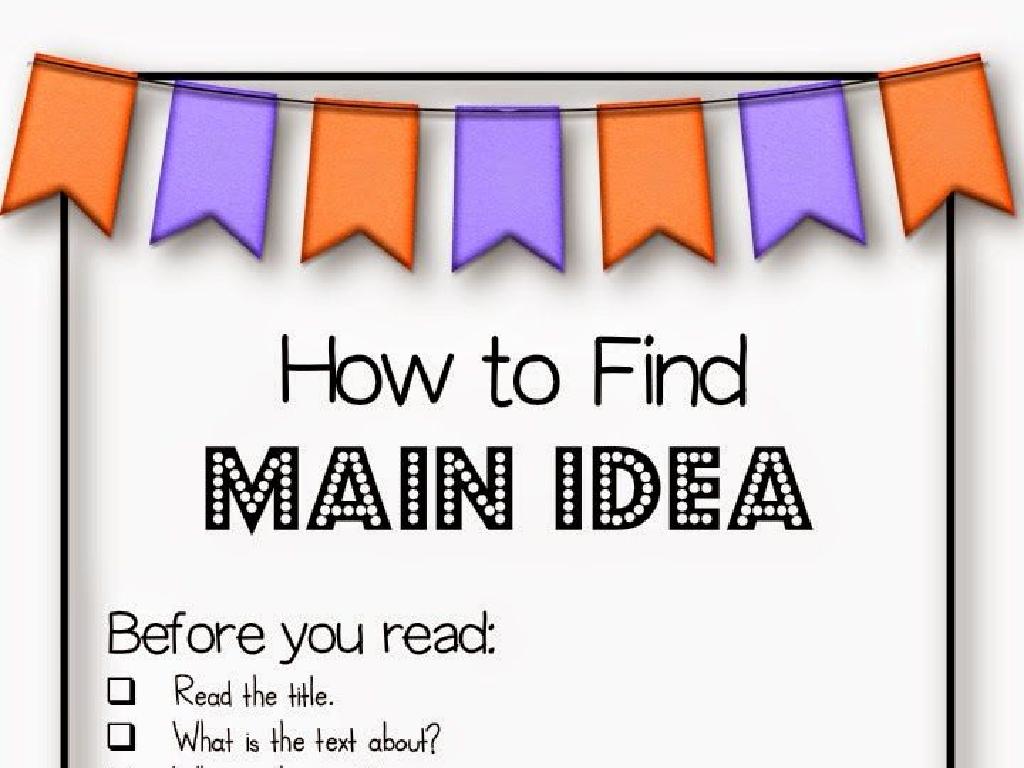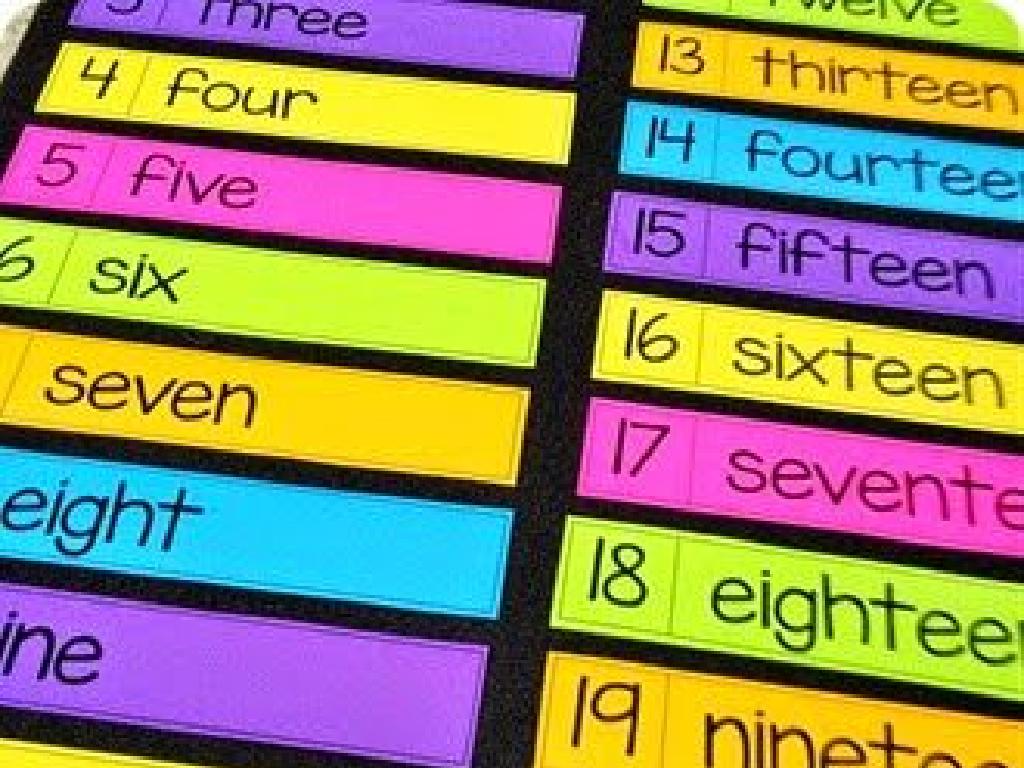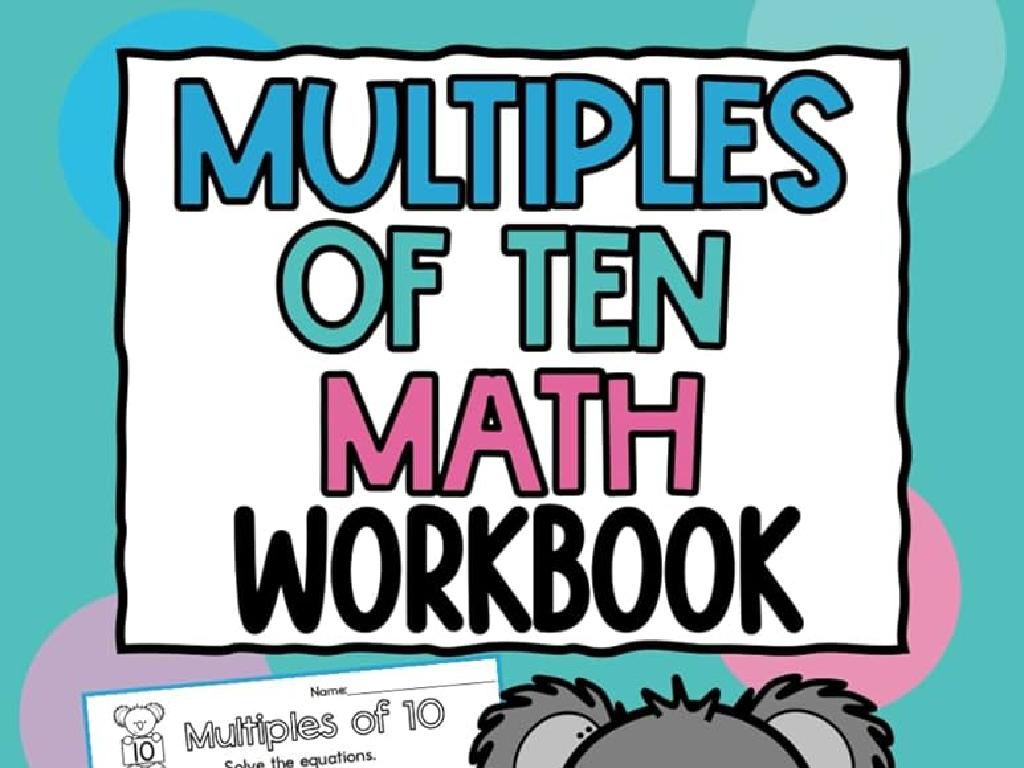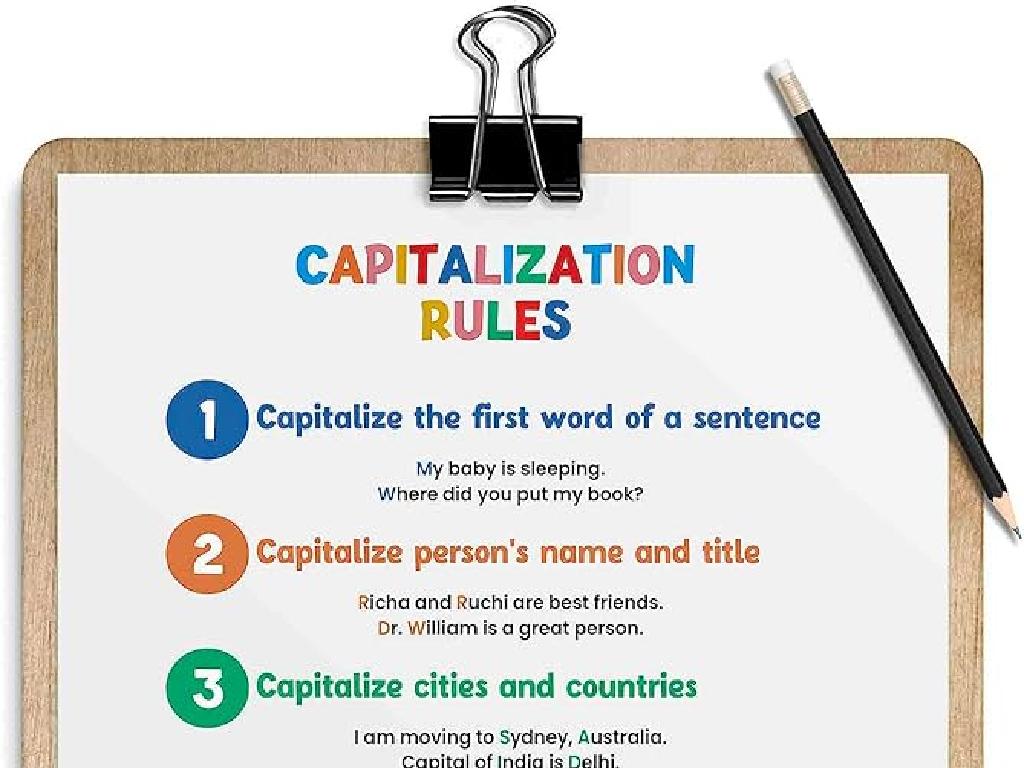Order Alphabetically Based On The First Two Letters
Subject: Language arts
Grade: Fourth grade
Topic: Reference Skills
Please LOG IN to download the presentation. Access is available to registered users only.
View More Content
Today’s Adventure: Ordering Words Alphabetically!
– Learn to sort words like the ABCs
– Alphabetical order is a key skill
– It helps us find words in dictionaries and names in lists
– Practice with fun word lists
– We’ll sort words by the first two letters
– Discover how it helps in real life
– Useful for libraries, schools, and in everyday life
|
This slide introduces the concept of alphabetical order, an essential reference skill for students. Begin by explaining that alphabetical order is the way we arrange words based on the letters of the alphabet, starting with the first letter and moving on to the second if the first letters are the same. Emphasize its importance by showing how it’s used in everyday life, such as finding a name in a contact list or a word in the dictionary. Engage the students with a fun activity where they practice ordering words from a list, focusing on the first two letters. Highlight real-life applications, like organizing books in a library or shopping lists. This will help students understand the practicality and necessity of this skill.
Understanding Alphabetical Order
– What is alphabetical order?
– It’s arranging words by ABC order, like in a dictionary.
– Alphabetizing is like sorting music
– Think of how you find a song by its first letter.
– Example: ‘Apple’ before ‘Banana’
– Just like ‘Apple’ comes before ‘Banana’ in a list.
|
This slide introduces the concept of alphabetical order to fourth-grade students, making it relatable by comparing it to organizing a music playlist. Emphasize that words are sorted based on the order of the letters in the alphabet, starting with the first letter and moving on to the second if the first letters are the same, and so on. Use everyday examples like sorting fruits or books to illustrate the point. Encourage students to think of other examples and to practice this skill by alphabetizing a list of words or items from their surroundings.
Alphabetical Order: Starting with the First Letter
– First letter’s role in ordering
– The first letter decides the word’s alphabetical position.
– Sorting words from A to Z
– Words are listed in order from the beginning to the end of the alphabet.
– Activity: Sorting words together
– We’ll practice sorting words by their first letter as a group.
|
This slide introduces the concept of alphabetical order, emphasizing the importance of the first letter in determining a word’s position in a list. Begin by explaining how the alphabet is a set of letters arranged in a specific order and that this order is used to sort words. For the activity, prepare a list of words and have students work together to arrange them alphabetically by the first letter. This can be done as a class, in small groups, or individually. Consider using common words that the students are familiar with to ensure the activity is engaging and appropriate for their level. Provide guidance and support as needed, and encourage students to explain their thought process as they sort the words.
Alphabetical Order: When First Letters Are the Same
– Words with same first letter
– Look at the second letter
– If the first letters match, the second letter decides the order
– ‘Car’ before ‘Cat’
– In ‘Car’ and ‘Cat’, ‘a’ is before ‘t’, so ‘Car’ comes first
– Practice with more examples
– Try ordering ‘Ball’, ‘Bat’, and ‘Bag’
|
This slide is aimed at teaching students how to order words alphabetically when they start with the same letter. Emphasize that they should look at the second letter of the words to determine their order. Use ‘Car’ and ‘Cat’ as a clear example to illustrate this point. Encourage students to practice this skill with additional examples, such as ‘Ball’, ‘Bat’, and ‘Bag’, to reinforce the concept. During the lesson, provide a list of words for the students to order as a class activity, ensuring they understand how to apply this method when the first two letters are the same.
Practice Time: Alphabetical Order
– Sort words together as a class
– Focus on the first two letters
– Where does ‘Bear’ fit?
– Does ‘Bear’ come before or after ‘Beetle’ and ‘Bird’?
– Let’s find out together!
|
This slide is designed for an interactive class activity to help students practice alphabetizing words by their first two letters. Start by explaining the importance of alphabetical order as a reference skill. Then, present the class with a list of words to sort together. Encourage students to participate by asking where ‘Bear’ would fit in a sequence with ‘Beetle’ and ‘Bird’. Guide them to see that ‘Bear’ comes after ‘Beetle’ but before ‘Bird’ because when looking at the first two letters, ‘Be’ is the same for all, so we look at the third letter. This activity will help reinforce the concept and give students confidence in their ability to alphabetize words. Provide additional examples if time allows and encourage students to explain their reasoning.
Alphabetical Order Games
– Learning through play
– Class sorting game
– We’ll sort words by their first two letters
– Engage with words
– Think about how words are ordered in a dictionary
– Fun and education combined
|
This slide introduces an interactive class activity focused on teaching students the concept of alphabetical order through a fun game. The objective is to reinforce their understanding of how to arrange words based on the first two letters, similar to how words are organized in a dictionary. The game will involve the whole class and will be a collaborative effort to sort a list of words together. This activity not only makes learning more enjoyable but also enhances the students’ reference skills in a practical way. As a teacher, prepare a list of words of varying lengths and complexities to accommodate all students. Consider grouping students and giving each group different sets of words to sort, or conducting a relay race where students take turns ordering words. The key is to make the activity lively and engaging, ensuring that the students learn while having a great time.
Class Activity: Alphabetical Order Challenge
– Receive a set of word cards
– Arrange cards in alphabetical order
– Start with the first two letters of each word
– Work as a team with your group
– Cooperation and communication are key
– We’ll review and discuss as a class
– Discuss any tricky words or ordering issues
|
This activity is designed to help students practice and reinforce their understanding of alphabetical order based on the first two letters of words. By working in groups, students will learn to collaborate and communicate effectively while they arrange their word cards. As a teacher, you will facilitate the activity, provide guidance, and ensure that each group understands the concept. After the activity, lead a discussion about any challenges faced and how they were overcome. This will help students learn from each other and clarify any misunderstandings. Prepare a diverse set of words to cater to different skill levels within the class.
Alphabetical Order: Homework Challenge
– Congrats on mastering ABC order!
– Homework: List favorite animals
– Think of animals you love the most
– Sort animals by first two letters
– For ‘Elephant’ and ‘Eagle’, ‘Ea’ comes before ‘El’
– Bring your sorted list to class
|
This slide wraps up the lesson on alphabetical order and sets up a practical homework assignment for the students. They are tasked with creating a list of their favorite animals and then sorting that list based on the first two letters of each animal’s name. This exercise will reinforce their understanding of alphabetical order and give them a chance to apply what they’ve learned in a fun and personal way. In the next class, students can compare lists and discuss any challenges they faced. This will also be an opportunity to celebrate their effort and success in learning this important reference skill.






